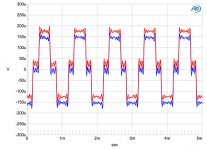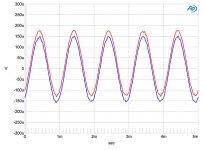squaring the number of chips raises SPL by 12dB) for building some mini size loudspeakers).
As well as the cost, current costs for 12" wafers are about $2.74/sq-cm scaling goes the wrong way here.
BTW this stuff reminds me of the "Audio Spotlight" modulated ultrasound to create sound via the non-linearity of air literally "out of thin air". I uses a big panel of small piezo transducers. I think the prototypes were no more special than the ones you get at Radio Shack.
Thanks Scott, that is what I was trying to get my old brain to remember. What happened to that, like all the other audio devices that were suppose to get rid of the moving coil speaker? I know they made it work and all but who knows what it sounded like? I thought it was a really interesting idea but never saw another word about it.
Thanks Scott, that is what I was trying to get my old brain to remember. What happened to that, like all the other audio devices that were suppose to get rid of the moving coil speaker? I know they made it work and all but who knows what it sounded like? I thought it was a really interesting idea but never saw another word about it.
I helped the original developer when it was his Phd thesis by getting him some free Sigma DSP boards/software.
Shocking effect a little weak on bass but the sound was generally OK. I figure the physics of air is basically not something that could be gotten around. 100's of Watts of ultra sound were needed to get the effect.
I heard it in their demo room --- recalled thin to no bass and OK sound but not HiFi even. The best thing they could demo was the ability to move/steer the image anywhere they wanted it to be placed. They thought that had great potential in automobiles or surround sound. But if they were using hundreds of watts to do it... that might have been the deal killer.
THx-RNMarsh
THx-RNMarsh
Just think of ultrasound cavitation of fat, blood, other liquids inside the body100's of Watts of ultra sound were needed to get the effect.
I heard it in their demo room --- recalled thin to no bass and OK sound but not HiFi even. The best thing they could demo was the ability to move/steer the image anywhere they wanted it to be placed. They thought that had great potential in automobiles or surround sound. But if they were using hundreds of watts to do it... that might have been the deal killer.
THx-RNMarsh
I still think it has Disney World/museum potential, personal narration, etc. You are right the quality was not much over dictation level.
But in post 62959 you said 'There you are! This is exactly what I/anyone with the appropriate test equipment can do, easily. And we have poor levels of distortion at higher levels (than -60) as well. These are quit audible levels to me. ' clearly implying that the higher low level distortion of the DS DAC shown were audible to you.
I'm intrigued as this might suggest that your route to nirvana might be a 24/96 multibit rather than the noise shaped output of a DS.
Personally I used a marantz CD80 for 20 years and only when I went server based for other rooms did I change DAC. I'm only about 12 years behind the curve now
It might be - I was hinting at that.... but are there any recommended sota ones being made now? The mid level distortion is high was my comment.
Noise shaping and dither are not good solutions IMO because they dont seem to increase resolution. Yes, they work, sort of, but at a cost in other areas. I want very low distortion at all levels and dynamic range to cover real world max range of recording. Both. If it cannot be done... then so be it.... but I'm going to get as close as humanly possible before quitting.
In my home system, I play mostly CD (& FM). Compared to my CD player, the change over to downloaded higher bit files was a very nice surprise. That caused an ugly fire-storm of controversy, unfortunately.
THx-RNMarsh
Last edited:
Just think of ultrasound cavitation of fat, blood, other liquids inside the body
I am extrapolating to audio use, the 90dB SPL model uses 50W. You can do the math. IIRC I heard a 180W prototype at one point, but I might be wrong.
Noise shaping and dither are not good solutions IMO because they dont seem to increase resolution. Yes, they work, sort of, but at a cost in other areas.
THx-RNMarsh
Dither is absolutely necessary, known since 1960 or so far predating IC's or digital audio, and it definitely does increase resolution. I read an article by the CTO of Benchmark this afternoon assuming dither of an ideal quantizer as if there was no other possibility.
EDIT - A nice read exposing some of the marketing tricks involved in promoting DSD. http://www.realhd-audio.com/?p=74
Last edited:
Dither is absolutely necessary, known since 1960 or so far predating IC's or digital audio, and it definitely does increase resolution. I read an article by the CTO of Benchmark this afternoon assuming dither of an ideal quantizer as if there was no other possibility.
Hmmmm. OK. I'll have to figure out why I dont like what it does, then. I seem to prefer more bits without dither. What do you think BenchMark is actually doing? They do manage to get 21 bits of use from the 24 bits. What else can get more of those 24 bits or how?
THx-RNmarsh
Last edited:
Figures you would have had a hand in that Scott. I can see plenty of places it would work for as you say the spoken word. You can cut through s lot of background noise if you can steer the sound to a specific location.
I was just the liaison of the week for our Media Lab participation.
Hmmmm. OK. I'll have to figure out why I dont like what it does, then. What do you think BenchMark is actually doing? They do manage to get 21 bits of use from the 24 bits. What else can get more of those 24 bits or how?
THx-RNmarsh
Read the interview it is very level headed on HD formats.
Where is the interview?
link in #63101 The writer is offered as house guru I don't know if he is CTO or whatever or if they even have one. In my experience the CTO is the oldest engineer that has decided that it is too much work to keep up with current technology and it is better to be empowered to bark orders.
Last edited:
Worthwhile mentioning these again, Pano has referenced them a couple of times, System Overview | Tectonic Audio Labs - proving that there are other ways, that work ...
Just think of ultrasound cavitation of fat, blood, other liquids inside the body
I'm thinking obesitas dance club, the wall(s) of parametrics
no wonder it takes so long for real progress to be made
I wonder ... I'm listening to 256K mp3's I personally converted from my
1999 CD collection (my transition - last purchased media) .
They still are really quite good (my flacs are a little better). Original L3 codec from
germany was quite advanced for the 20th century.
But nothing has really changed ...besides sound card 16>24 bit dac's and win98
to 7 . No real "groundbreaking" improvements - AT ALL .
PS - in fact , many "backward" downgrades in service/ease of use - freedom.
Artistic innovation and mastering quality was better at the end of the 20th century.
Kind of "evens out" , actually.
OS
Dither is absolutely necessary, known since 1960 or so far predating IC's or digital audio, and it definitely does increase resolution. I read an article by the CTO of Benchmark this afternoon assuming dither of an ideal quantizer as if there was no other possibility.
EDIT - A nice read exposing some of the marketing tricks involved in promoting DSD. John Siau: Benchmark Audio Guru | Real HD-Audio
Ok I read the white paper by BenchMark....... 16 bit systems (CD's) I agree they absolutely ought to be dithered.... Here is that 16bit undithered at -90dB. that poor signal waveform needs to go away and probably well before -90dB. So, you reduce the bits or dynamic range....... but to be rid of the noise created by dithering, Benchmark adds a step to shift some or all the noise to above the audio range. They refer to it as "Properly-dithered" throughout the paper.
 -90 undithered 16b
-90 undithered 16bA 24 bit will never add noise to the system (-144dB). And, doesnt need to be dithered at all or until way below -90dB. Possibly the noise floor itself will do the dithering.
 -90 undithered 24b
-90 undithered 24b 24b word lengths provide a very efficient method of improving the noise performance.
Now, I dont know and I should try to find out, if the 16b/44.1 CD player I've used for years (Sony) even added dither or did added it and did they do it 'properly".
But clearly whether 24 bit files used or didnt use dithering, I wouldnt notice it at -144dB area or where ever the noise floor actual is. So, I tentatively doubt dither was responsible for the improved sound of 24b files.... unless the increased dynamic range was a part of it.
THx-RNMarsh
Last edited:
- Status
- Not open for further replies.
- Home
- Member Areas
- The Lounge
- John Curl's Blowtorch preamplifier part II